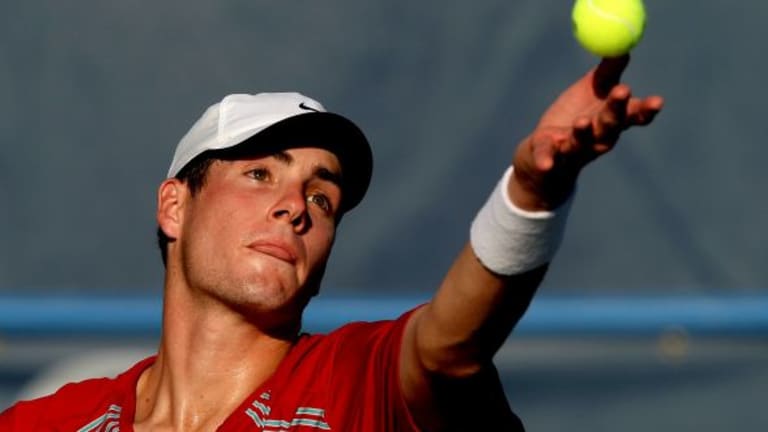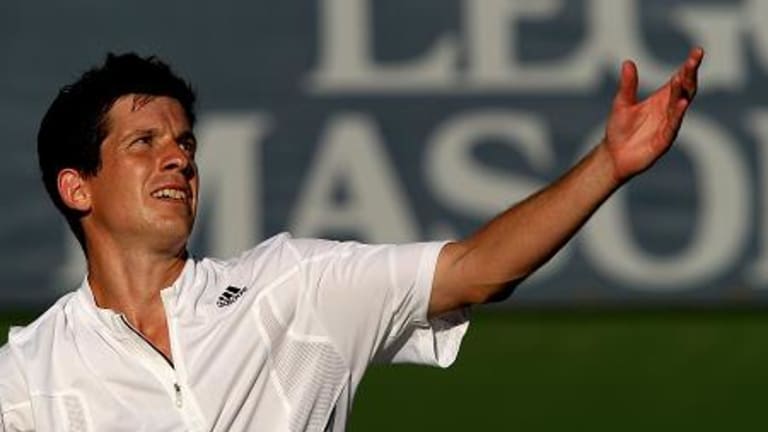The early bird always gets the worm, or so the saying goes. But what’s a girl to do arriving an hour before the gates open on Day Three of The Legg Mason Tennis Classic? And that's two hours before any matches begin? Walk… walk, look and listen, because the sights and sounds sure are different than what they’ll be in a couple short hours.
Luckily, the trailers, tents, and fencing that mark off the official grounds of the William H. G. Fitzgerald Tennis Center are not impenetrable, and quite a few others also arrived early, hoping to catch a glimpse of Marat Safin practicing, or Andy Roddick hitting a few huge serves. Who knows, you might even encounter a guy who looks all of 6-10 firing off cross-court forehands on Match Court 3 - which is exactly what happened to me.
I couldn’t take my eyes off the big man and knew if I stared long enough his name could pop in my head. But, no. It didn't. But two young lads standing next to me at the fence knew more than I did.
“Do you know who that is?” I asked.
“Yeah, it’s John Isner,” one said.
I didn’t want to sound uninformed, or totally uncool ,so I paused a second before adding, “He looks familiar. Where’s he from?”
“North Carolina, but he went to school at the University of Georgia.”
“Oh…” I exclaimed. “That’s NCAA champ John Isner!”
“Yeah,” the young man said, shaking his head up and down, like finally I’d seen the light.
And, I had. Practicing on the other side of the chain-link fence and windscreen was the college senior who this year had helped his University of Georgia squad win the NCAA's team and doubles championships. He was in The Legg Mason as a wild card. Turns out that the youth who identified Isner for me was Mitch Herb, whose father – Tom Herb – was John's coach at Georgia.
And in a short time, John was going to play probably the biggest match of his life on Center Court at a US Open Series event against an international favorite, frequent Top Tenner and Wimbledon semifinalist, Tim Henman. John didn’t look nervous, but maybe that's because you don't associate that with men so big; this kid's head practically brushed the branches of the blooming Crepe Myrtle trees scattered around the grounds. We would see.
I turned away and strolled along the practice courts, stopping to watch Sebastien Grosjean. Wow… that amazing cross-court forehand still has a bite. However, I learned from the woman standing next to me that Sebastien already lost his first-round match - in three sets, to Russia's Igor Kunitsyn.
“Maybe he’s staying here to support his fellow Frenchmen,” the woman added. Arnaud Clement is defending champion, and the draw also includes Michael Llodra and Julien Benneteau. So having cries of “Allez!” coming from the stands could make a difference for those three remaining Frenchmen.
Two young boys of about 5 or 6, with their dad, were also watching Sebastian hit. Their noses were pressed to the fence and their eyes wide, as they clung to their junior racquets. Then… Bang! A ball slammed in the fence, right in front of the children.
“This is way better than TV, Dad!” one said. “Wow… did you see that, Dad?”
These two kids were enough to reassure anyone in earshot that tennis can really get you going: Can we see Roddick tonight? He’s a seed, Daddy. What time is it now? Will he be on soon? When are they going to start playing?
It was hard to walk away from such enthusiasm.
The grounds were coming to life as the minutes ticked by. Volunteers arrived, ball kids poured into the big white tent just east of Center Court, ice was carted to coolers on court, to food stands, and to the players lounge and first aid stations, all against a background of balls popping off strings, assuring early arrivals that they were in for an afternoon of world-class tennis. Security guards gathering near the North Gate, too, as people lined up for the 3 PM official opening of the gates. Little plastic strips were secured to each backpack, computer case, or bag that had passed inspection.
A bell finally rang. We were off.
The noise level jumped inside the grounds. Two rows of concessions lined the walkway from the entrance. The Wilson crew was busy setting out racks of hats and other wares, including the new K-Series Racquets and giant tennis balls better suited to collecting autographs than batting back and forth over a net - unless it was a volleyball net. Raymond Weil, the watch manufacturer, had pretty display. South African Air had a promotion going, and eager hands and eyes pored over the drawsheet.
I stopped at one court to watch local favorite Paul Goldstein, from nearby Rockville, Maryland, hit with a young player I did not recognize. Thomas Blake stood off the the deuce side, watching. He had his hair pulled back, but those locks are recognizable in or out of a hair band. A small crowd quickly gathered, as soon as Thomas’s name spread.
“Awesome…” one teen said, “I want his autograph.”
According to the In The Spotlight feature on the drawsheet, this is Paul Goldstein’s 14th year playing Legg Mason. His first-round match would be with Somdev Dev Varman, a qualifier here, and the 2007 NCAA singles champion from The University of Virginia. Varman is one of four NCAA singles champions playing this week - the others are Bob Bryan (1998), Amer Delic (2003) and Benjamin Becker (2004).
Making my way to the south side of the stadium court to check out what’s going on, I see Lars Graf, the consummate ATP chair umpire. He headed toward the trailer where groups of linesmen and fellow chair umpires were gathered to get their court assignments for the day’s matches.
Tommy Haas, the Number Two seed, and Thomas Johansson were having hit on Court One. Nice to see Thomas J. hitting again; he spent months off the tour with a detached retina. I’ve got my eyes on Johansson this week; he’s a sleeper and Washington could be his launching pad for a fine summer on the hard courts of American circuit. But Tommy Haas gets the bulk of the attention. His bare, tanned chest, and buff physique are showstoppers. One ball girl snaps a shot of Tommy with her cell phone, whispering to her nearby friends, “I love you, Tommy.”
It’s 4 PM - time for the first round to get underway. I find a seat on the shady side of Center Court just as the umpire intones, “Time.”
Tim Henman and John Isner are poised to start what would turn out to be a stunning match. With his 6’ 9” lanky frame and powerful serve, Isner is a formidable opponent. He hangs in there with Henman, loosening up as the games click off. Half an hour into the match, they’re on serve at 4-games. At 15-40, Isner bravely serves an ace, but Henman breaks with a passing shot.
A few years back, a tough, focused Henman might have closed the set with no problems. But he just doesn't look confident today. Maybe it was the pressure coming from the NCAA doubles champ, but he goes down, 15-40, while serving for the set against a neophyte. Henman’s ground strokes are flying long, wide and into the net. He doesn't even seem capable of staying with the ball as he makes contact. Instead, he pops up, straight, before finishing his stroke and follow-through. But what sets a serve-and-volley player apart from the baseliner is often his serve, and Henman serves his way out of trouble to win the set, 6-4.
Both players find a high level as the second set gets underway. Isner comes to the net more frequently than before, but Henman often answers with brilliant passing shots. Again, each player holds to 4-all, and now the tension was palpable on court - and in the stands. For a relatively unknown player, John Isner has plenty of fans; they cry out, “Come on, John!” Henman’s fans are quick to drown them out. Isner holds to go up 5-4, and again Henman' groundies start to fail. They are short. One whacks the netcord. Game to Isner, it's all tied.

